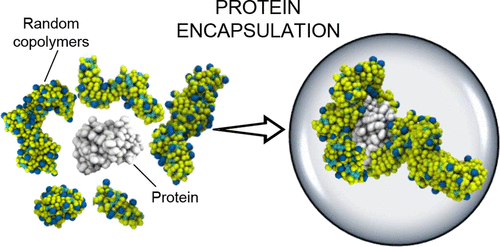Our official English website, www.x-mol.net, welcomes your
feedback! (Note: you will need to create a separate account there.)
A Modeling-Based Design to Engineering Protein Hydrogels with Random Copolymers
ACS Nano ( IF 15.8 ) Pub Date : 2021-10-13 , DOI: 10.1021/acsnano.1c04955 Annalisa Cardellini 1, 2 , Felipe Jiménez-Ángeles 2 , Pietro Asinari 1, 3 , Monica Olvera de la Cruz 2, 4
ACS Nano ( IF 15.8 ) Pub Date : 2021-10-13 , DOI: 10.1021/acsnano.1c04955 Annalisa Cardellini 1, 2 , Felipe Jiménez-Ángeles 2 , Pietro Asinari 1, 3 , Monica Olvera de la Cruz 2, 4
Affiliation

|
Protein enzymes have shown great potential in numerous technological applications. However, the design of supporting materials is needed to preserve protein functionality outside their native environment. Direct enzyme–polymer self-assembly offers a promising alternative to immobilize proteins in an aqueous solution, achieving higher control of their stability and enzymatic activity in industrial applications. Herein, we propose a modeling-based design to engineering hydrogels of cytochrome P450 and of PETase with styrene/2-vinylpyridine (2VP) random copolymers. By tuning the copolymer fraction of polar groups and of charged groups via quaternization of 2VP for coassembly with cytochrome P450 and via sulfonation of styrene for coassembly with PETase, we provide quantitative guidelines to select either a protein–polymer hydrogel structure or a single-protein encapsulation. The results highlight that, regardless of the protein surface domains, the presence of polar interactions and hydration effects promote the formation of a more elongated enzyme–polymer complex, suggesting a membrane-like coassembly. On the other hand, the effectiveness of a single-protein encapsulation is reached by decreasing the fraction of polar groups and by increasing the charge fraction up to 15%. Our computational analysis demonstrates that the enzyme–polymer assemblies are first promoted by the hydrophobic interactions which lead the protein nonpolar residues to achieve the maximum coverage and to play the role of the most robust contact points. The mechanisms of coassembly are unveiled in the light of both protein and polymer physical-chemistry, providing bioconjugate phase diagrams for the optimal material design.
中文翻译:

一种基于建模的设计,用于设计具有随机共聚物的蛋白质水凝胶
蛋白质酶在众多技术应用中显示出巨大的潜力。然而,需要设计支持材料以在其天然环境之外保留蛋白质功能。直接酶-聚合物自组装为将蛋白质固定在水溶液中提供了一种有前景的替代方法,可在工业应用中更好地控制其稳定性和酶活性。在此,我们提出了一种基于建模的设计,用于工程细胞色素 P450 和 PETase 与苯乙烯/2-乙烯基吡啶 (2VP) 无规共聚物的水凝胶。通过调节极性基团和带电基团的共聚物分数,通过 2VP 季铵化与细胞色素 P450 共组装,并通过苯乙烯磺化与 PETase 共组装,我们提供定量指南来选择蛋白质-聚合物水凝胶结构或单蛋白质封装。结果强调,无论蛋白质表面结构域如何,极性相互作用和水合效应的存在促进了更长的酶-聚合物复合物的形成,表明存在膜状共组装。另一方面,通过降低极性基团的比例和将电荷比例增加到 15% 来达到单一蛋白质封装的有效性。我们的计算分析表明,酶-聚合物组装首先受到疏水相互作用的促进,这导致蛋白质非极性残基实现最大覆盖并发挥最稳健的接触点的作用。
更新日期:2021-10-26
中文翻译:

一种基于建模的设计,用于设计具有随机共聚物的蛋白质水凝胶
蛋白质酶在众多技术应用中显示出巨大的潜力。然而,需要设计支持材料以在其天然环境之外保留蛋白质功能。直接酶-聚合物自组装为将蛋白质固定在水溶液中提供了一种有前景的替代方法,可在工业应用中更好地控制其稳定性和酶活性。在此,我们提出了一种基于建模的设计,用于工程细胞色素 P450 和 PETase 与苯乙烯/2-乙烯基吡啶 (2VP) 无规共聚物的水凝胶。通过调节极性基团和带电基团的共聚物分数,通过 2VP 季铵化与细胞色素 P450 共组装,并通过苯乙烯磺化与 PETase 共组装,我们提供定量指南来选择蛋白质-聚合物水凝胶结构或单蛋白质封装。结果强调,无论蛋白质表面结构域如何,极性相互作用和水合效应的存在促进了更长的酶-聚合物复合物的形成,表明存在膜状共组装。另一方面,通过降低极性基团的比例和将电荷比例增加到 15% 来达到单一蛋白质封装的有效性。我们的计算分析表明,酶-聚合物组装首先受到疏水相互作用的促进,这导致蛋白质非极性残基实现最大覆盖并发挥最稳健的接触点的作用。











































 京公网安备 11010802027423号
京公网安备 11010802027423号